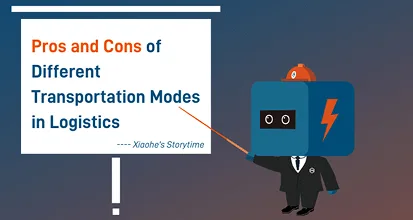In international trade, understanding the advantages and disadvantages of various transportation modes is crucial. Joining MOOV‘s mascot “Xiaohe” as we delve into the pros and cons of different modes of transportation to help you make better choices for your specific needs.
Xiaohe: “Hello, everyone! I’m Xiaohe, the mascot of MOOV. Today, I’m here to enlighten you about the pros and cons of different transportation modes in international logistics. In international trade, we rely heavily on logistics services to transport various goods. Each transportation mode has its characteristics and suitable scenarios. Let’s dive into the advantages and limitations of each mode!
Air Freight Forwarding:
- Advantages:
Speed: The fastest mode of transportation, reducing transit times significantly.
Reliability: Airlines adhere to strict schedules, ensuring timely delivery and reducing the risk of delays.
Global Reach: Air freight provides easy access to remote locations and worldwide markets, making it ideal for time-sensitive and perishable goods.
- Disadvantages:
Cost: Air transportation is generally more expensive due to higher fuel costs and limited cargo capacity.
Weight and Size Restrictions: Bulky or heavy goods may not be suitable for air transportation.
Environmental Impact: Air freight emits a higher level of carbon dioxide than other modes, which is a growing concern.
- What goods are suitable for air freight?
Urgent items where transit time is critical, such as medical supplies and perishable goods, as well as lightweight valuable items, such as jewelry and electronic products.
Ocean Freight Forwarding:
- Advantages:
Cost-Effective: An economical transport option, especially for large shipments.
Cargo Capacity: Ocean freight offers substantial cargo capacity, making it ideal for bulk shipments.
Sustainability: It is considered a greener alternative, emitting fewer greenhouse gases.
- Disadvantages:
Transit Time: Ocean transportation can be slower than air or rail due to fixed schedules and potential delays.
Infrastructure Dependency: Ocean freight relies on port infrastructure, and disruptions or inefficiencies can cause delays and additional costs.
- What goods are suitable for ocean freight?
Large and heavy goods like machinery, automobiles, and bulk shipments. Goods with lower urgency compared to air are more suited to ocean freight.
Rail Freight Forwarding:
- Advantages:
Cost and Efficiency: Rail transportation offers a middle ground between ocean and air in terms of speed and cost. Generally cheaper than air and faster than the ocean, rail is an affordable, faster transport option.
Capacity and Flexibility: Rail freight can handle a considerable volume of goods and provides flexibility in transporting various types of cargo.
Sustainability: Rail transport is more environmentally friendly than air but less than the ocean, emitting fewer carbon emissions.
- Disadvantages:
Limited Network Coverage: Rail transport infrastructure may not be as extensive as road or Ocean networks in certain regions.
Intermodal Challenges: Coordination with other modes of transportation may be required for seamless delivery.
- What goods are suitable for rail transport?
Heavy machinery and vehicles.
Xiaohe: “Remember, when choosing the suitable transportation mode, consider the nature of your goods, transit time requirements, and environmental factors. Sometimes, a single mode may not fulfill all your needs, and that’s where multi-modal transportation comes into play. MOOV understands the intricacies of transporting various types of goods in different industries. We welcome discussions about your unique logistics needs and look forward to creating a more innovative and sustainable future together.”

